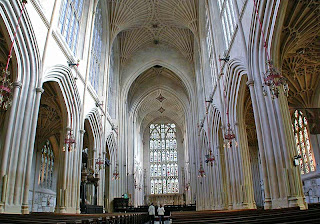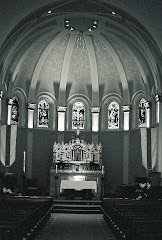The Stations of the Cross are a wonderful devotion, especially during Lent and Holy Week. Read what is happening in the station. Say the prayer. then look at the picture. Meditate on the scene: What is Jesus thinking and feeling? What is happening to the bystanders? What does this mean in my life? What does this scene say about God, etc.? Then say the prayer at the end. Just so you know the prayers I am using are same as the pope used a few years ago. The Pictures of the Stations are from Holy Cross Parish in Kaukauna, Wisconsin.
FIRST STATION
Jesus is condemned to death
V/. We adore you, O Christ, and we bless you.
R/. Because by your holy Cross you have redeemed the world.
PRAYER
Lord Jesus Christ, you accepted an unjust judgment.
Grant to us and to all the men and women of our time
the grace to remain faithful to the truth.
Do not allow the weight of responsibility
for the sufferings of the innocent
fall upon us and upon those who come after us.
To you, O Jesus, just Judge,
be honour and glory for ever and ever.
R. Amen.
SECOND STATION
Jesus takes up his Cross
V/. We adore you, O Christ, and we bless you.
R/. Because by your holy Cross you have redeemed the world.
PRAYER
Lord Jesus Christ, who accept the Cross at the hands of men
to make of it the sign
of God’s saving love for humanity,
grant us and all the men and women of our time
the grace of faith in this infinite love.
By passing on to the new millennium
the sign of the Cross,
may we be authentic witnesses to the Redemption.
To you, O Jesus, Priest and Victim,
be praise and glory for ever.
R. Amen.
THIRD STATION
Jesus falls the first time
V/. We adore you, O Christ, and we bless you.
R/. Because by your holy Cross you have redeemed the world.
PRAYER
O Christ, as you fall under the weight of our faults
and rise again for our justification,
we pray, help us
and all who are weighed down by sin
to stand up again
and continue the journey.
Give us the strength of the Spirit
to carry with you the cross of our weakness.
To you, O Jesus, crushed under the weight of our faults
be our praise and love for ever.
R. Amen.
FOURTH STATION
Jesus meets his Mother
V/. We adore you, O Christ, and we bless you.
R/. Because by your holy Cross you have redeemed the world.
PRAYER
O Mary, who walked
the way of the Cross with your Son,
your mother’s heart torn by grief,
but mindful always of your fiat
and fully confident that He to whom nothing is impossible
would be able to fulfil his promises,
implore for us and for the generations yet to come
the grace of surrender to God’s love.
Help us, in the face of suffering, rejection, and trial,
however prolonged and severe,
never to doubt his love.
To Jesus, your Son,
honour and glory for ever and ever.
R. Amen.
FIFTH STATION
Simon of Cyrene helps Jesus to carry his Cross
V/. We adore you, O Christ, and we bless you.
R/. Because by your holy Cross you have redeemed the world.
PRAYER
O Christ, you gave to Simon of Cyrene
the dignity of carrying your Cross.
Welcome us too under its weight,
welcome all men and women
and grant to everyone the gift of readiness to serve.
Do not permit that we should turn away from those
who are crushed by the cross of illness
loneliness, hunger or injustice.
As we carry each other’s burdens,
help us to become witnesses to the gospel of the Cross
and witnesses to you,
who live and reign for ever and ever.
R. Amen.
SIXTH STATION
Veronica wipes the face of Jesus
V/. We adore you, O Christ, and we bless you.
R/. Because by your holy Cross you have redeemed the world.
PRAYER
Lord Jesus Christ,
you accepted a woman’s
selfless gesture of love,
and in exchange ordained
that future generations should remember her
by the name of your face.
Grant that our works
and the works of all who will come after us
will make us like unto you
and will leave in the world the reflection
of your infinite love.
To you, O Jesus, splendour of the Father’s glory,
be praise and glory for ever.
R. Amen.
SEVENTH STATION
Jesus falls the second time
V/. We adore you, O Christ, and we bless you.
R/. Because by your holy Cross you have redeemed the world.
PRAYER
Lord Jesus Christ,
you fall under the weight of human sin
and you get up again in order to take it upon yourself and cancel it.
Give to us, weak men and women,
the strength to carry the cross of daily life
and to get up again from our falls,
so that we may bring to future generations
the Gospel of your saving power.
To you, O Jesus, our support when we are weak,
be praise and glory for ever.
R. Amen.
EIGHTH STATION
Jesus speaks to the women of Jerusalem
V/. We adore you, O Christ, and we bless you.
R/. Because by your holy Cross you have redeemed the world.
PRAYER
O Christ, you came into this world
to visit all those who await salvation.
Grant that our generation
will recognize the time of its visitation
and share in the fruits of your redemption.
Do not permit that there should be weeping for us
and for the men and women of the new century
because we have rejected our merciful Father’s outstretched hand.
To you, O Jesus, born of the Virgin Daughter of Zion,
be honour and praise for ever and ever.
R. Amen.
NINTH STATION
Jesus falls the third time
V/. We adore you, O Christ, and we bless you.
R/. Because by your holy Cross you have redeemed the world.
PRAYER
Lord Jesus Christ,
through your humiliation beneath the Cross
you revealed to the world the price of its redemption.
Grant to the men and women of the third millennium
the light of faith,
so that, as they recognize in you
the Suffering Servant of God and man,
they may have the courage to follow the same path
which, by way of the Cross and self-emptying,
leads to life without end.
To you, O Jesus, our support when we are weak,
be honour and glory for ever.
R. Amen.
TENTH STATION
Jesus is stripped of his clothes
V/. We adore you, O Christ, and we bless you.
R/. Because by your holy Cross you have redeemed the world.
PRAYER
Lord Jesus,
who, with supreme dedication,
accepted death on the Cross for our salvation,
grant to us and to all the world’s people
a share in your sacrifice on the Cross,
so that what we are and what we do
may always be a free and conscious sharing
in your work of salvation.
To you, O Jesus, Priest and Victim,
be honour and glory for ever.
R. Amen.
ELEVENTH STATION
Jesus is nailed to the Cross
V/. We adore you, O Christ, and we bless you.
R/. Because by your holy Cross you have redeemed the world.
PRAYER
O Christ lifted high,
O Love crucified,
fill our hearts with your love,
that we may see in your Cross
the sign of our redemption
and, drawn by your wounds,
we may live and die with you,
who live and reign with the Father and the Spirit,
now and for ever.
R. Amen.
TWELFTH STATION
Jesus dies on the Cross
V/. We adore you, O Christ, and we bless you.
R/. Because by your holy Cross you have redeemed the world.
PRAYER
Lord Jesus Christ,
in the moment of your agony
you were not indifferent to humanity’s fate,
and with your last breath
you entrusted to the Father’s mercy
the men and women of every age,
with all their weaknesses and sins.
Fill us and the generations yet to come
with your Spirit of love,
so that our indifference
will not render vain in us
the fruits of your death.
To you, crucified Jesus, the wisdom and the power of God,
be honour and glory for ever and ever.
R. Amen.
THIRTEENTH STATION
Jesus is taken down from the Cross and given to his Mother
V/. We adore you, O Christ, and we bless you.
R/. Because by your holy Cross you have redeemed the world.
PRAYER
Salve, Regina, Mater misericordiæ;
vita dulcedo et spes nostra, salve.
Ad te clamamus...
illos tuos misericordes oculos ad nos converte
et Iesum, benedictum fructum ventris tui,
nobis post hoc exilium ostende.
Implore for us the grace of faith, hope and charity,
so that we, like you,
may stand without flinching beneath the Cross
until our last breath.
To your Son, Jesus, our Saviour,
with the Father and the Holy Spirit,
all honour and glory for ever and ever.
R. Amen.
FOURTEENTH STATION
Jesus is laid in the tomb
V/. We adore you, O Christ, and we bless you.
R/. Because by your holy cross you have redeemed the world.
PRAYER
Lord Jesus Christ,
by the power of the Holy Spirit,
you were drawn by the Father
from the darkness of death
to the light of a new life in glory.
Grant that the sign of the empty tomb
may speak to us and to future generations
and become a wellspring of living faith,
generous love,
and unshakeable hope.
To you, O Jesus, whose presence, hidden and victorious,
fills the history of the world,
be honour and glory for ever and ever.
R. Amen.










































